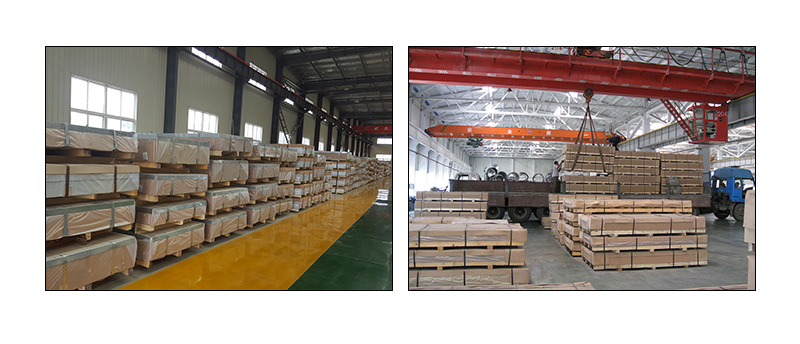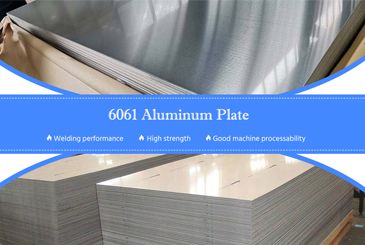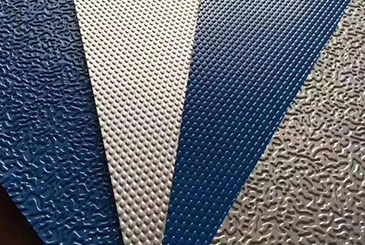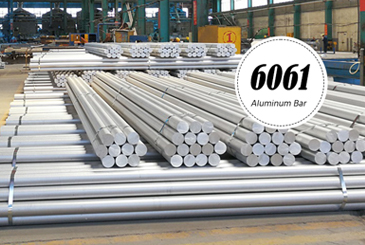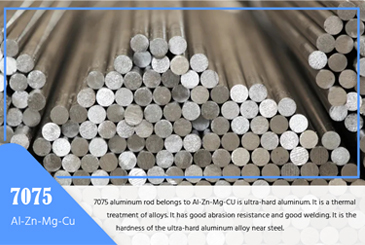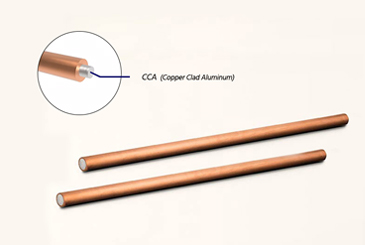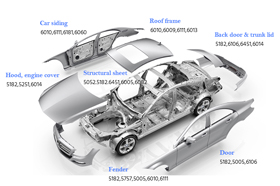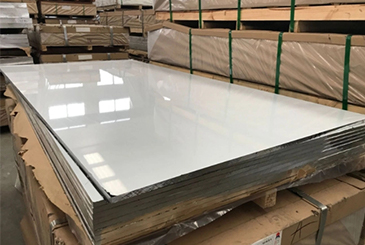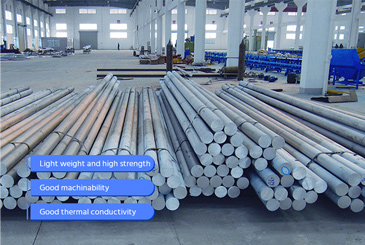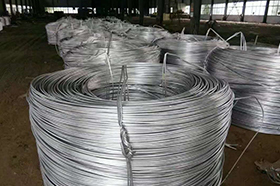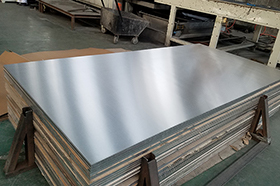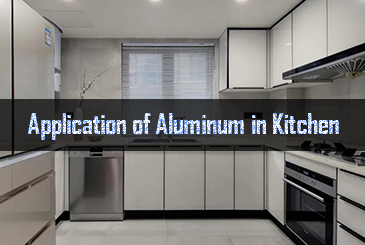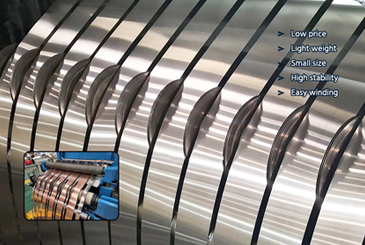This article will specifically study the two aluminum alloys of 2024 and 7075. By understanding the chemical composition, mechanical performance, yield strength, industry application and price advantages of these two alloys, it will help you clearly understand the differences between the two, and the common application areas of each aluminum alloy. Good choice, let's explore this article below.

What is 2024 aluminum alloy?
2024 aluminum alloy is the most well -known aircraft aluminum alloy. When you need a alloy material with excellent intensity weight ratio, it is an ideal alloy. 2024 Aluminum has excellent strength and anti -fatigue, which makes it very suitable for application in the aerospace field.
The main alloy elements in the 2000 series of aluminum aluminum aluminum alloy aluminum alloy are copper. The standard is AMS 4035 or QQ-A-250/4 or GB/T 3190-2017.Due to its high copper content, the corrosion resistance of 2024 is slightly lower. It usually uses or covers a layer of high -purity aluminum with anode oxidation surface to protect. 2024 Aluminum alloy has the characteristics of high strength and anti -fatigue, good processing, and good cutting. However, its corrosion resistance and weldingability are poor. When welding, it is usually vulnerable to the influence of thermal cracks and stress corrosion, and can only be welded, seam welded or flash welding.
The following are the best-selling products of 2024 aluminum alloy:
-
2024 O T4 T3 T351 Aluminium Sheet Plate
Temper:T3, T4, T6, T351, T451, T851
Standard: AMS-QQ-A-250/4, ASTM B209, AMS4037 2024
-
2024 T3 T351 T851 Aluminum Bar
Temper: T3, T351, T3511, T4, T42, T851
Standard: AMS-QQ-A-225/6, AMS-QQ-A-200/3, EN 573-3-1994
-
2024 T3 T4 Drawn Aluminum Tube
Temper:O, T3, T4, T6
Standard: ASTM B210, AMS 4088, AMS 4087, AMS-WWT-700/3
-
2024 T8 T351 Aluminum Extrusion Profile
Temper:O, T3, T8, T351, T3511, T8511
Standard: AMS-4152, ASTM-B221, AMS-QQ-A-200/3
-
2024 T3 T351 T851 Aluminum Foil
Temper:T3, T351, T851, T361, T4, T6
Standard: AMS 4044, ASTM B209, MIL-DTL-15272
-
2024 T3 T4 T351 T851 Aluminum Wire
Temper:T3, T4, T351, T851, O
Standard: AMS-QQ-A-250/4, ASTM B21, EN 573-3
What is 7075 aluminum alloy?
7075 aluminum alloy is an aluminum alloy with zinc as the main alloy element. This makes 7075 have higher strength and higher strength weight ratio.Its standard is AMS-QQ-A-225/9 or GB/T3880-2017. 7075 aluminum is the lightest and strongest aluminum, as strong as steel, has good fatigue strength and average cutting processing. This is the key feature of aerospace, defense military industry and other industries. However, due to the high alloy component of 7075 aluminum, the hardness is extremely high. Therefore, welding and suppression are very difficult.
The following are the best-selling products of 7075 aluminum alloy:
-
7075 T651 T7651 T7351 Aluminum Sheet Plate
Temper:T6, T651, T62, T652, T76, T7651, T73, T7351
Standard: AMS-QQ-250/3, ASTM B247, BS 2 L88
-
7075 T6 T651 Aluminum Rod Rar
Temper:O, T6, T651, T7351
Standard: AMS 4122 7075-T6, AMS 4123 7075-T651 , AMS 4124 7075-T7351
-
7075 T6 T352 T73 T74 Aluminum Forging
Temper:T6, T352, T73, T74
Standard: AMS 4126 7075-T6, AMS 4141 7075-T73, AMS 4147 7075-T7352
-
7075 T74511 T76511 Aluminum Profile
Temper:T3, T4, T6, T7451, T7651, T7452, T74511, T76511
Standard: AMS 4154, AMS 4166, BSL160
-
7075 O T6 T7351 Aluminum Wire
Temper:O, T6, T7351
Standard: AMS 4122 7075-T6, AMS 4124 7075-T7351 , AMS 4187 7075-O
-
7075 Mobile Middle Plate Aluminum Sheet
Temper:T6, T651
Standard: ASTM B209, EN 485
NO.1 2024 vs 7075 Aluminum Alloy Chemical Composition
| Element | Composition (%) | |
| 2024 Alloy | 7075 Alloy | |
| Si | 0.5 | 0.4 |
| Fe | 0.5 | 0.5 |
| Cu | 3.8-4.9 | 1.2-2.0 |
| Mn | 0.3-0.9 | 0.3 |
| Mg | 1.2-1.8 | 2.1-2.9 |
| Cr | 0.1 | 0.18-0.28 |
| Ni | - | - |
| Zn | 0.25 | 5.1-6.1 |
| Ti | 0.15 | 0.2 |
| Others:Each | 0.05 | 0.05 |
| Others:Total | 0.15 | 0.15 |
| Aluminiumin | Remainder | Remainder |
NO.2 2024 vs 7075 Aluminum Alloy Specification
| Alloy | 2024 | 7075 |
| Thickness (mm) | 1-500 | 1-300 |
| Width (mm) | 500-2650 | 500-3000 |
| Length (mm) | 500-16000 | 1000-12000 |
NO.3 2024 VS 7075 Aluminum Alloy Status
| Alloy | 2024 | 7075 |
| Temper | O, T3, T351, T3510, T3511, T36, T361, T4, T42, T6, T62, T651, T72, T8, T81, T851, T8510, T8511, T861 | O, T6, T62, T651, T6510, T6511, T652, T7, T73, T7351, T73510, T73511, T7352, T76, T7651, T765100, T76511, T62,T652 |
NO.4 2024 vs 7075 Aluminum Material Type
2024 aluminum alloy can usually be made into:
- 2024 aluminum alloy thick plates
- 2024 t3 aluminum plate
- 2024 t851 aluminum sheet plate
- 2024 ultra -thick aluminum plate
- 2024 T4, T651, T651 aluminum bar
- 2024 aluminum tube
- 2024 Aluminum profile
- 2024 Aluminum Corner
7075 aluminum alloy can usually be made into:
- 7075 T6 aluminum sheet plate
- 7075 Quenched Pre-stretched Aluminum Plate
- 7075 mold aluminum plate
- 7075 ultra -thick aluminum plate
- Forged 7075 t6 aluminum plate
- 7075 T6, T651 aluminum forging
- 7075 aluminum bar
- 7075 aluminum tube
- 7075-t6 aluminum tent pole
NO.5 2024 vs 7075 Aluminum Mechanical Properties
Below is a comparison of some material properties between 2024 and 7075 aluminum alloys to highlight their differences. For ease of understanding, this article selects 2024 t3 VS 7075 t6, which are the most representative alloys for comparison.
In order to better analyze and understand these two types of aluminum alloys, we have summarized the following table (2024 vs 7075 Mechanical Properties), hoping to be helpful to you.
| Material properties | 2024 | 7075 |
| Yield strength | 483 MPa | 503 MPa |
| Modulus of Elasticity | 73.1 GPa | 71.7 GPa |
| Thermal conductivity | 121-202 W/(m·K) | 130-190 W/(m·K) |
| Melting point | 500 - 650°C | 477 - 635°C |
| Hardness (Brinell) | 120-150HB | 150-200HB |
| Machinability | Good | Fair |
2024 vs 7075 Aluminum Yield Strength
The yield strength of a material is called the maximum stress at which it begins permanent deformation. In contrast, the yield strength of 7075 aluminum is higher than that of 2024 aluminum. This allows 7075 aluminum to withstand higher impacts and pressures for a period of time without deformation. It is determined by the chemical composition and heat treatment of 7075 aluminum alloy.
Of course, the 2024 aluminum alloy industry should not be considered fragile, as its yield strength of 483 MPa is also much higher than most alloys.
2024 vs 7075 Aluminum Modulus of Elasticity
It can be considered as the "stiffness" of an alloy; It measures the degree to which a material resists plastic deformation. Materials with higher modulus are considered more elastic because more work is required to permanently deform the material.
2024 aluminum alloy has a higher elastic modulus than 7075 aluminum alloy (73.1 GPa vs 71.7 GPa), and when we compare the Young's tensile modulus of the two alloys, their values do not differ significantly.
2024 vs 7075 Aluminum Thermal Conductivity
Thermal conductivity is an indicator used to quantify the ability of a material to transfer or conduct heat. Usually, aluminum alloys are not used for insulation. This is because all forms of aluminum alloy are good thermal conductors. The chemical composition of two heat-treated aluminum alloys has a significant impact on their thermal conductivity.
In this case, the thermal conductivity of 2024 aluminum is slightly higher than that of 7075 aluminum (130-190 W/(m · K) vs 121-202 W/(m · K).Due to the high copper content in 2024 aluminum alloy, copper has a lower thermal conductivity, resulting in a lower overall thermal conductivity. The content of zinc and copper in 7075 aluminum alloy is relatively high, and zinc and copper have high thermal conductivity, therefore the overall thermal conductivity is relatively high.
Overall, 7075 aluminum alloy has higher thermal conductivity compared to 2024 aluminum alloy, which is very important in some situations that require rapid heat dissipation, such as high-speed engines and aircraft. However, in some applications that do not require high thermal conductivity, the thermal conductivity of 2024 aluminum alloy is sufficient, and its processing performance is relatively good, with lower costs. Therefore, it is necessary to choose appropriate aluminum alloy materials based on specific application scenarios and needs.
2024 vs 7075 Aluminum Temperature Resistance
We analyzed the temperature resistance of 7075 t6 and 2024 t6 by comparing their melting points. The melting point of 7075 aluminum is slightly lower than that of 2024 aluminum (477-635 ° C vs 500-650 ° C). Therefore, 2024 alloy is more capable of withstanding higher temperatures than 7075 alloy. However, it should be noted that 7075 aluminum alloy exhibits excellent reaction to heat treatment. It can evenly distribute other alloy components in the metal.
2024 vs 7075 Aluminum Hardness
7075 aluminum is the highest strength to weight ratio among all aluminum alloys, therefore this alloy is mainly used in the aerospace and defense industries. The hardness of 7075 T6 aluminum is higher than that of 2024 T3 aluminum (150-200 HB vs. 120-150 HB). Compared with 7075 aluminum alloy, 2024 aluminum alloy has lower strength and toughness, but has better workability and weldability. Due to its excellent fatigue and corrosion resistance, it has been widely used in the aviation industry.
Overall, 7075 aluminum alloy has higher hardness and strength compared to 2024 aluminum alloy, but due to its poor processability and weldability, production costs are also higher. Therefore, in practical applications, it is necessary to choose appropriate materials based on specific circumstances. For many applications in the industry, its hardness is also sufficient.
2024 vs 7075 Aluminum machinability
2024 aluminum alloy has good machinability and can be processed through various processes such as extrusion, stretching, casting, and deep drawing. However, cracks and deformation are prone to occur during the processing, requiring special process control and design.
7075 aluminum alloy contains high zinc and copper elements, so it is easy to produce tool wear and riveting difficulties in the processing process. Therefore, the machinability of 7075 aluminum alloy is relatively poor, and special process control and design measures need to be taken, such as high-temperature processing and surface coating, to improve its machinability.
Overall, 2024 aluminum alloy has better machinability compared to 7075 aluminum alloy, but its strength and toughness are relatively low. 7075 aluminum alloy has higher strength and toughness, but its machinability is poor, and special measures need to be taken to improve its machinability. Therefore, in practical applications, it is necessary to choose appropriate materials and processing techniques based on specific circumstances to meet the requirements of the product.
NO.6 2024 vs 7075 Aluminum Corrosion Resistance
2024 aluminum alloy contains a high proportion of copper, therefore it has high strength and toughness, but relatively speaking, its corrosion resistance is poor. 2024 aluminum alloy is prone to corrosion in humid environment and is vulnerable to stress corrosion cracking. Therefore, in some applications that require high corrosion resistance, such as maritime navigation and coastal areas, 2024 aluminum alloy requires special corrosion protection measures.
7075 aluminum alloy contains elements such as zinc, magnesium, copper, etc. The addition of these elements makes 7075 aluminum alloy have higher strength and better corrosion resistance. 7075 aluminum alloy is a high-strength and excellent corrosion resistance aluminum alloy material, which can be used in various applications that require high strength and corrosion resistance.
In summary, compared to 2024 aluminum alloy, 7075 aluminum alloy has better corrosion resistance. However, it should be noted that in some special environments, 7075 aluminum alloy still needs to take appropriate anti-corrosion measures to extend its service life.
NO.7 2024 vs 7075 Aluminum Welding Performance
2024 aluminum is known to be more challenging to weld compared to other aluminum alloys due to its high copper content, which can lead to hot cracking and reduced weldability. It requires careful welding techniques and proper filler material selection to mitigate these issues. Additionally, 2024 aluminum can be prone to heat-affected zone (HAZ) cracking during welding, which requires precise control of welding parameters, such as heat input and travel speed, to minimize the risk of cracking.
On the other hand, 7075 aluminum is generally considered to have better weldability compared to 2024 aluminum. It is a heat-treatable alloy with lower copper content, which reduces the likelihood of hot cracking during welding. However, 7075 aluminum still requires proper welding techniques and control of welding parameters to ensure good weld quality. Preheating and post-weld heat treatment may also be required for certain welding applications to minimize the risk of cracking and optimize the mechanical properties of the welded joints.
In both cases, proper welding procedures, including thorough cleaning of the base material, appropriate filler material selection, careful control of heat input and travel speed, and consideration of post-weld heat treatment, can help achieve good welding performance for 2024 and 7075 aluminum alloys. It's important to follow established welding practices and consult relevant welding codes and specifications to ensure successful welding of these high-strength aluminum alloys.
NO.8 2024 Aluminmu vs 7075 Aluminum Weight
The density of 2024 aluminum alloy is 2.78 g/cm3 (0.1 LB/IN3), and its weight is roughly the same as pure aluminum.
The density of 7075 aluminum alloy is 2.81 G/CM3 (0.102 LB/IN3), which is slightly greater than pure aluminum, and its weight is higher. It is also one of the reasons for 2024 aluminum alloy. It is much lighter, so it can be made for light -quality framework for aerospace.
You can click on the aluminum weight calculation to learn more about the specific weight of the alloy.
NO.9 2024 vs 7075 Aluminum Applications
2024 Aluminum Alloy Application
2024 aluminum alloy is one of the most popular high-strength alloys. Variant alloys with higher purity, such as 2124 and 2324, have higher strength. 2024 aluminum has excellent machinability, good machinability, high strength, and can be coated with corrosion-resistant coatings, making it the best choice for aerospace and vehicle applications. 2024 aluminum can be used in many industries, including but not limited to the following:
- Aviation and space industry: aircraft shell, airfoil, propeller, engine parts, etc.
- Military industry: aviation rockets, ships, weapons and equipment, and armored vehicles.
- Automotive industry: Automotive body structure, wheels, engine components, etc.
- Electronic industry: computer parts, electronic device casings, etc.
- Machinery manufacturing industry: nuts, bolts, bearings, etc.

7075 Aluminum Alloy Application
7075 aluminum alloy is widely used in aviation, aerospace, national defense, transportation, sports goods, mold manufacturing, mechanical manufacturing, and other fields due to its high strength, excellent wear resistance, and corrosion resistance, including but not limited to the following aspects:
- Aerospace: manufacturing aircraft main structure, engine parts, elevator, etc
- Defense and military industry: manufacturing military products such as rocket warheads, weapon components, tank bodies, armored vehicles, and ships
- Transportation: braking systems, engine mounts, frames, wheels, and other components of automobiles, trains, and ships
- Sports equipment: manufacturing ski boards, golf clubs, 7075 aluminum bike frames, motorcycles and other sports equipment
- Mechanical manufacturing: manufacturing die-casting molds, extrusion molds, precision machining equipment, automation equipment and other mechanical manufacturing fields
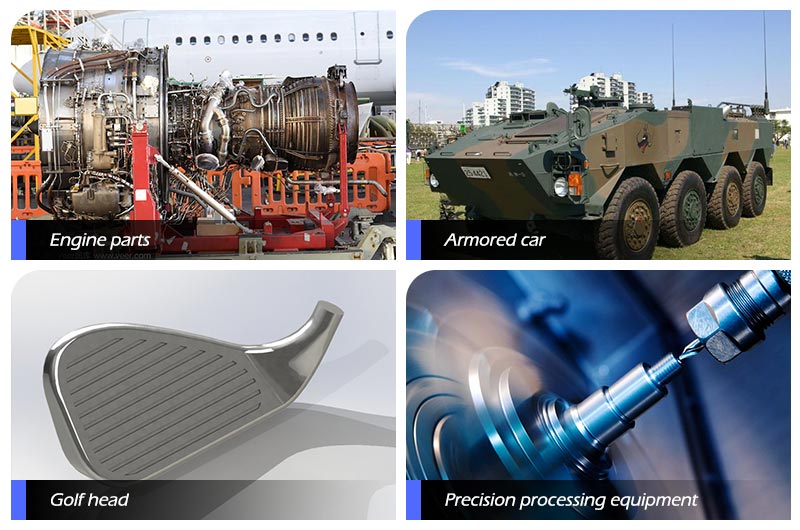
NO.10 2024 vs 7075 Aluminum Price
Generally speaking, the 7075 aluminum price is higher than that of 2024 aluminum alloy. This is because 7075 aluminum alloy has higher strength and better corrosion resistance, while the 2024 aluminum price is relatively low, making it suitable for some applications where strength requirements are not particularly high.
It should be emphasized that the price of aluminum alloys is influenced by various factors such as market supply and demand and material specifications, and price changes are also normal. Therefore, when purchasing aluminum alloy materials, it is necessary to choose appropriate materials and suppliers based on specific needs.
Comprehensive Summary
2024 aluminum alloy and 7075 aluminum alloy are common high-strength aluminum alloy materials with certain similarities, but there are also some differences. Therefore, when selecting these two types of aluminum alloys, it is necessary to evaluate and select them based on specific needs and application scenarios.
7075 aluminum alloy has higher strength and better corrosion resistance. Therefore, in some application fields that require high strength and corrosion resistance, such as aviation, national defense, automobiles, etc., the demand for 7075 aluminum alloy is relatively large, and the supply and demand relationship is tight, so the price is relatively high. If your project needs to be applied in the aerospace or military fields, then naturally 7075 aluminum alloy is preferred.
2024 aluminum alloy has a high copper content, slightly lower corrosion resistance, and good processing performance, making it suitable for some applications with low strength requirements. If your project requires better machinability, you can choose 2024 aluminum alloy because it has better performance in processing and forming.
If you want to choose the most suitable alloy material, you need a wealth of professional aluminum knowledge. Chalco (China supplier/factory, high-quality manufacture) can help you in this regard. We are a large modern Chinese aluminum processing enterprise that integrates scientific research, processing, and manufacturing.
The company can produce 1-8 series aluminum plates, strips, and foils with complete specifications, enormous production capacity, extensive inventory, and competitive prices, ensuring high-quality manufacture and meeting your personalized processing needs. The product has passed CE-ISO9001 certification and can be customized according to customer requirements, including Japanese standards, European standards, American standards, and more.
For detailed inquiries, you can contact us directly or check our inventory information.
